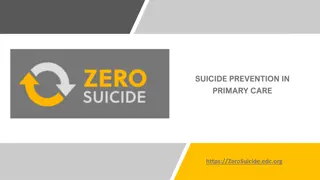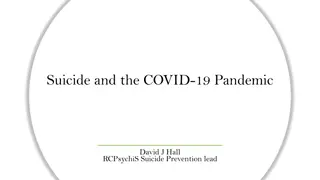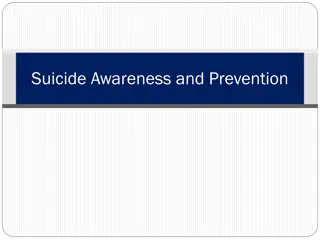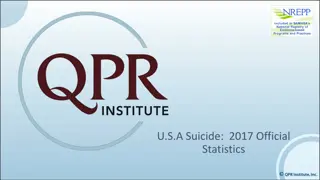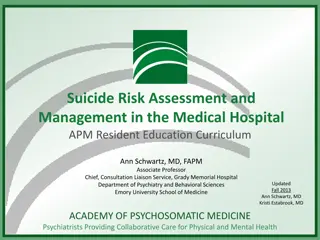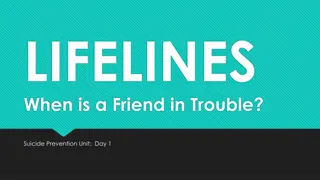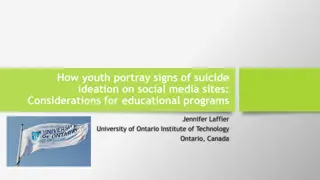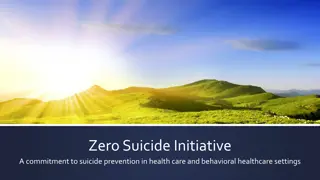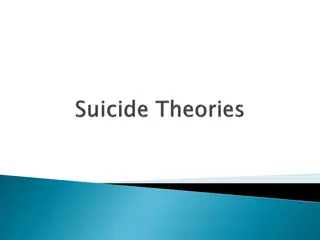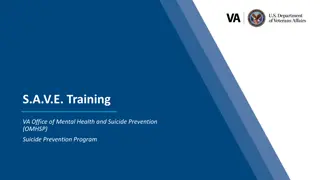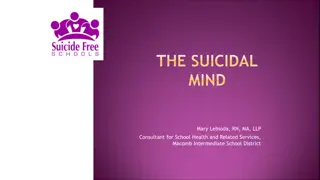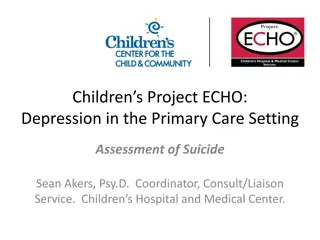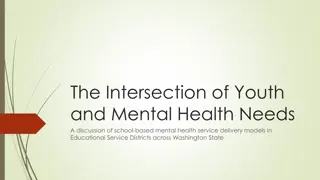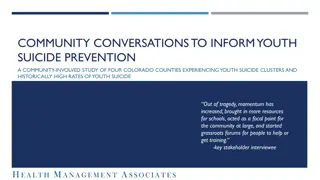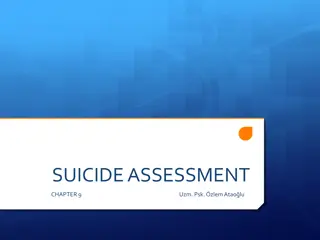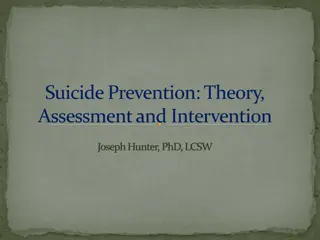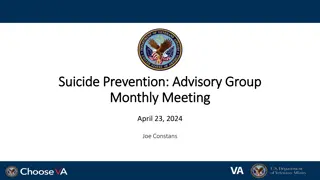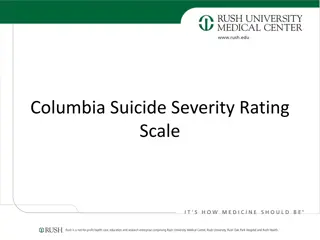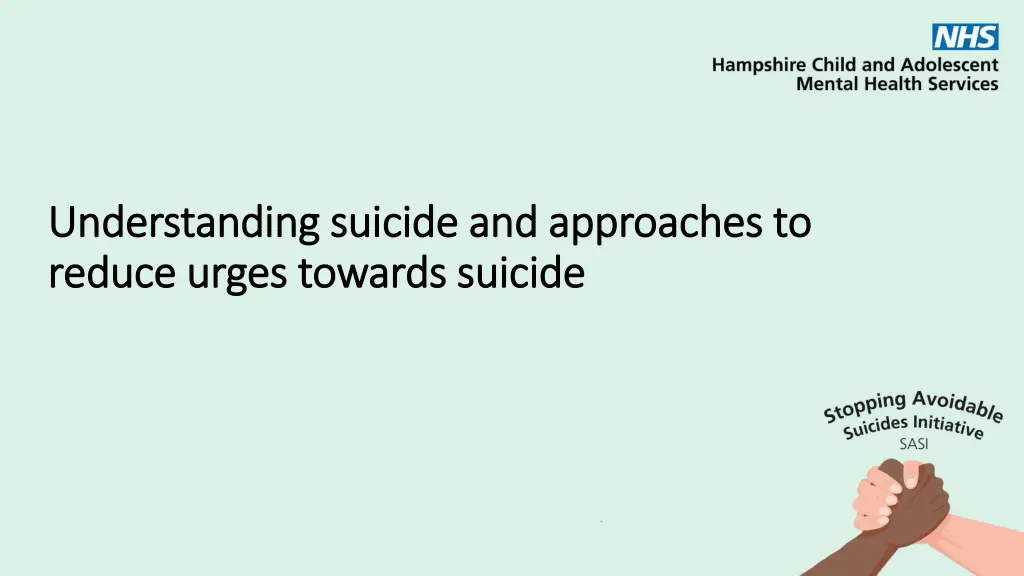
Understanding Suicide and Suicidal Behavior
Explore the complexities of suicidal behavior, including non-suicidal self-injury, suicidal ideation, and suicidal intent. Learn about the drivers for suicidal thinking and actions, as well as the urge to escape distressing situations. Delve into reasons for living versus reasons for dying, and understand the psychological pain, hopelessness, and self-hate that can contribute to suicidal urges.
Download Presentation

Please find below an Image/Link to download the presentation.
The content on the website is provided AS IS for your information and personal use only. It may not be sold, licensed, or shared on other websites without obtaining consent from the author. If you encounter any issues during the download, it is possible that the publisher has removed the file from their server.
You are allowed to download the files provided on this website for personal or commercial use, subject to the condition that they are used lawfully. All files are the property of their respective owners.
The content on the website is provided AS IS for your information and personal use only. It may not be sold, licensed, or shared on other websites without obtaining consent from the author.
E N D
Presentation Transcript
Understanding suicide and approaches to Understanding suicide and approaches to reduce urges towards suicide reduce urges towards suicide
What do we mean? Non-suicidal self-injury (self-harm): Non-suicidal self-injury (NSSI), defined as the deliberate, self-inflicted destruction of body tissue without suicidal intent and for purposes not socially sanctioned, includes behaviors such as cutting, burning, biting and scratching skin. Suicidal Ideation: Suicidal ideations (SI), often called suicidal thoughts or ideas, is a broad term used to describe a range of contemplations, wishes, and preoccupations with death and suicide.
What do we mean? Suicidal Intent: To have suicidal intent is to have suicide or deliberate self- killing as one's purpose. Intent refers to the aim, purpose, or goal of the behavior rather than the behavior itself. The term connotes a conscious desire or wish to leave or escape from life, and also connotes a resolve to act. Suicide Attempt: A suicide attempt is when someone harms themselves with any intent to end their life, but they do not die as a result of their actions
Suicide as an urge to escape The situation that the person is experiencing is distressing and is leading to an urge to escape. Escape is a natural urge within our bodies when we are in a situation that we believe we cannot influence for the better.
Drivers for Suicidal Thinking and Actions Psychological pain - I am in unbearable pain from my thoughts and emotions. Agitation I can t settle, I m irritable and can t think straight. Hopelessness I cannot see anything good for the future. Self- Hate The person I am is completely unacceptable to me and I believe it is unacceptable to others. Stress I cannot manage the demands in my life there are problems that are too big to solve.
Drivers for Suicidal Thinking and Actions Reasons for Living VS Reasons for Dying
Sadness I do not belong, I have lost an important connection. Shame I am unacceptable to people as I am. Guilt I have wronged someone. Hopelessness I have lost my ability to problem solve and to influence my own life.
Stages of thinking towards suicide I m noticing that my life feels really difficult to live as it is as the moment (various reasons). I would love to escape my life as it is right now (thoughts, emotions, situations, sensations). I have the power to end my life, so escape is an option. I feel I have no choice but to end my life because: - If people knew these things about me, they would abandon me. - I cannot solve this situation I am in. - I am a burden on other people. - I cannot see any way of things changing in the future.
Work together on your table to think about the 5 drivers for suicide. Psychological pain - I am in unbearable pain from my thoughts and emotions. Agitation I can t settle, I m irritable and can t think straight. Hopelessness I cannot see anything good for the future. Self- Hate The person I am is completely unacceptable to me and I believe it is unacceptable to others. Stress I cannot manage the demands in my life there are problems that are too big to solve. A) What situations might lead to the drivers? B) What might be things that reduce the impact of these drivers in those situations?
Responding to immediate distress Distraction to refocus attention and with others to connect and refocus attention: Soothing activities to support nervous system Self-compassion Body calming exercise, breathing, changing temperature, shaking out muscles
Validation through to Problem Solving The emotions and distress being felt are hugely valid they make sense given the person s experiences, their history, their biology and their humanness. The urge to escape is valid when we feel completely overwhelmed and at a loss of how to fix things. The person needs to jump on board your validation, soothing and problem-solving abilities to support them to avoid ending their lives.
Actively listen Articulate the emotion/urge Reflect back Makes sense given situation Take seriously and respond honestly Makes sense given history
Practice exercise Think about some of the difficult feelings that young people have come to you with - how could you use validation to help to regulate emotion? Makes sense given history Articulate the emotion/urge Makes sense given situation the
Window of Tolerance Hyperarousal anger, agitation, anxiety feeling out of control, not thinking straight may add to drivers for suicide Hyperarousal numbness, hopelessness, difficulty enjoying anything, withdrawal
Window of Tolerance What are your experiences of seeing hyperarousal at school? What are your experiences of seeing hypoarousal at school?
Emotions Give Us Information- signal that something is happening. But emotions are not fact! Emotions Communicate to, and Influence, Others - Facial expressions and body posture say a lot about how we are feeling. Emotions Prepare us for Action - Specific emotions have an action urge that is often biologically hardwired .
Finding wise mind Strong emotions can determine our actions without the balance of logical analysis of the situation . Strong emotions can leave us with tunnel vision about the possible ways out of a difficult situation. People can become fixed on suicide as the only way out . Tunnel vision Catastrophising Wise Mind Logical Mind Emotional Mind Impaired problem solving Impulsivity
Situation Action urge Action Emotion Emotional reactivity Emotion Action urge Response to emotion Situation How helpful ill this action be? Does it bring down the intensity of the emotion without harm? Notice mindfully what is the whole picture? How does it fit what is the function of this emotion? Wise mind response to the emotion. Problem solving and acceptance.
Situation Action urge Action Emotion Emotional reactivity Emotion Action urge Response to emotion Situation Validation Self-compassion for any self-hate Connection and soothing from other people Refocussing on people who matter A rumour goes around school about sexuality Shame I am unacceptable as I am Suicide
Your turn Situation Emotion Action urge Response to emotion Mock exam result comes back as failed
Your turn Situation Emotion Action urge Response to emotion Your choice
How to problem solve 1. Validate before problem solving 2. Find what the specific problem is - what is this emotion telling us? think back to function of emotion. 3. Generate different solutions for this problem 4. Discuss advantages/disadvantages (short and long term) of each solution 5. Agree on a solution and create a plan 6. Validate that this solution might not 100% solve the problem
How to problem solve practice exercise Use an example of a problem from someone on your table. Go through the steps for problem solving this problem. 1. Validate before problem solving 2. Find what the specific problem is - what is this emotion telling us? 3. Generate different solutions for this problem 4. Discuss advantages/disadvantages (short and long term) of each solution 5. Agree on a solution and create a plan 6. Validate that this solution might not 100% solve the problem
Cope ahead Describe an upcoming situation. Decide how you want to effectively respond. Imagine the situation in your mind. Rehearse in your mind what you will do to cope effectively.
Cope ahead Practice exercise Use an example of a situation which is likely to be tricky for someone on your table. Go through the steps of coping ahead. Describe the upcoming situation. Decide how you want to effectively respond. Imagine the situation in your mind. Rehearse in your mind what you will do to cope effectively.

